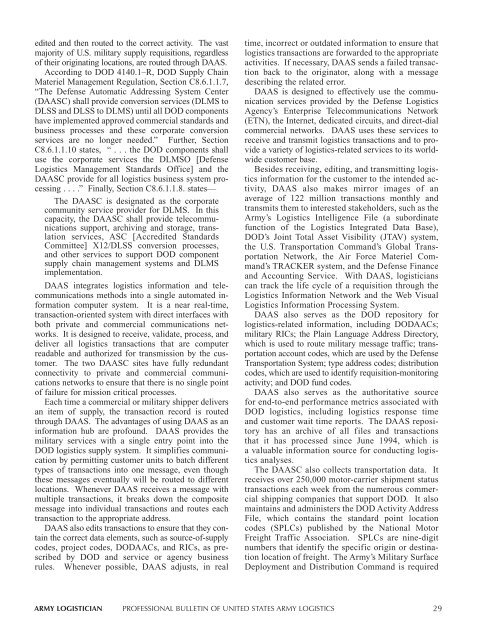Supporting the First Stryker Brigade in Iraq - Army Logistics ...
Supporting the First Stryker Brigade in Iraq - Army Logistics ...
Supporting the First Stryker Brigade in Iraq - Army Logistics ...
Create successful ePaper yourself
Turn your PDF publications into a flip-book with our unique Google optimized e-Paper software.
edited and <strong>the</strong>n routed to <strong>the</strong> correct activity. The vast<br />
majority of U.S. military supply requisitions, regardless<br />
of <strong>the</strong>ir orig<strong>in</strong>at<strong>in</strong>g locations, are routed through DAAS.<br />
Accord<strong>in</strong>g to DOD 4140.1–R, DOD Supply Cha<strong>in</strong><br />
Materiel Management Regulation, Section C8.6.1.1.7,<br />
“The Defense Automatic Address<strong>in</strong>g System Center<br />
(DAASC) shall provide conversion services (DLMS to<br />
DLSS and DLSS to DLMS) until all DOD components<br />
have implemented approved commercial standards and<br />
bus<strong>in</strong>ess processes and <strong>the</strong>se corporate conversion<br />
services are no longer needed.” Fur<strong>the</strong>r, Section<br />
C8.6.1.1.10 states, “ . . . <strong>the</strong> DOD components shall<br />
use <strong>the</strong> corporate services <strong>the</strong> DLMSO [Defense<br />
<strong>Logistics</strong> Management Standards Office] and <strong>the</strong><br />
DAASC provide for all logistics bus<strong>in</strong>ess system process<strong>in</strong>g<br />
. . . .” F<strong>in</strong>ally, Section C8.6.1.1.8. states—<br />
The DAASC is designated as <strong>the</strong> corporate<br />
community service provider for DLMS. In this<br />
capacity, <strong>the</strong> DAASC shall provide telecommunications<br />
support, archiv<strong>in</strong>g and storage, translation<br />
services, ASC [Accredited Standards<br />
Committee] X12/DLSS conversion processes,<br />
and o<strong>the</strong>r services to support DOD component<br />
supply cha<strong>in</strong> management systems and DLMS<br />
implementation.<br />
DAAS <strong>in</strong>tegrates logistics <strong>in</strong>formation and telecommunications<br />
methods <strong>in</strong>to a s<strong>in</strong>gle automated <strong>in</strong>formation<br />
computer system. It is a near real-time,<br />
transaction-oriented system with direct <strong>in</strong>terfaces with<br />
both private and commercial communications networks.<br />
It is designed to receive, validate, process, and<br />
deliver all logistics transactions that are computer<br />
readable and authorized for transmission by <strong>the</strong> customer.<br />
The two DAASC sites have fully redundant<br />
connectivity to private and commercial communications<br />
networks to ensure that <strong>the</strong>re is no s<strong>in</strong>gle po<strong>in</strong>t<br />
of failure for mission critical processes.<br />
Each time a commercial or military shipper delivers<br />
an item of supply, <strong>the</strong> transaction record is routed<br />
through DAAS. The advantages of us<strong>in</strong>g DAAS as an<br />
<strong>in</strong>formation hub are profound. DAAS provides <strong>the</strong><br />
military services with a s<strong>in</strong>gle entry po<strong>in</strong>t <strong>in</strong>to <strong>the</strong><br />
DOD logistics supply system. It simplifies communication<br />
by permitt<strong>in</strong>g customer units to batch different<br />
types of transactions <strong>in</strong>to one message, even though<br />
<strong>the</strong>se messages eventually will be routed to different<br />
locations. Whenever DAAS receives a message with<br />
multiple transactions, it breaks down <strong>the</strong> composite<br />
message <strong>in</strong>to <strong>in</strong>dividual transactions and routes each<br />
transaction to <strong>the</strong> appropriate address.<br />
DAAS also edits transactions to ensure that <strong>the</strong>y conta<strong>in</strong><br />
<strong>the</strong> correct data elements, such as source-of-supply<br />
codes, project codes, DODAACs, and RICs, as prescribed<br />
by DOD and service or agency bus<strong>in</strong>ess<br />
rules. Whenever possible, DAAS adjusts, <strong>in</strong> real<br />
time, <strong>in</strong>correct or outdated <strong>in</strong>formation to ensure that<br />
logistics transactions are forwarded to <strong>the</strong> appropriate<br />
activities. If necessary, DAAS sends a failed transaction<br />
back to <strong>the</strong> orig<strong>in</strong>ator, along with a message<br />
describ<strong>in</strong>g <strong>the</strong> related error.<br />
DAAS is designed to effectively use <strong>the</strong> communication<br />
services provided by <strong>the</strong> Defense <strong>Logistics</strong><br />
Agency’s Enterprise Telecommunications Network<br />
(ETN), <strong>the</strong> Internet, dedicated circuits, and direct-dial<br />
commercial networks. DAAS uses <strong>the</strong>se services to<br />
receive and transmit logistics transactions and to provide<br />
a variety of logistics-related services to its worldwide<br />
customer base.<br />
Besides receiv<strong>in</strong>g, edit<strong>in</strong>g, and transmitt<strong>in</strong>g logistics<br />
<strong>in</strong>formation for <strong>the</strong> customer to <strong>the</strong> <strong>in</strong>tended activity,<br />
DAAS also makes mirror images of an<br />
average of 122 million transactions monthly and<br />
transmits <strong>the</strong>m to <strong>in</strong>terested stakeholders, such as <strong>the</strong><br />
<strong>Army</strong>’s <strong>Logistics</strong> Intelligence File (a subord<strong>in</strong>ate<br />
function of <strong>the</strong> <strong>Logistics</strong> Integrated Data Base),<br />
DOD’s Jo<strong>in</strong>t Total Asset Visibility (JTAV) system,<br />
<strong>the</strong> U.S. Transportation Command’s Global Transportation<br />
Network, <strong>the</strong> Air Force Materiel Command’s<br />
TRACKER system, and <strong>the</strong> Defense F<strong>in</strong>ance<br />
and Account<strong>in</strong>g Service. With DAAS, logisticians<br />
can track <strong>the</strong> life cycle of a requisition through <strong>the</strong><br />
<strong>Logistics</strong> Information Network and <strong>the</strong> Web Visual<br />
<strong>Logistics</strong> Information Process<strong>in</strong>g System.<br />
DAAS also serves as <strong>the</strong> DOD repository for<br />
logistics-related <strong>in</strong>formation, <strong>in</strong>clud<strong>in</strong>g DODAACs;<br />
military RICs; <strong>the</strong> Pla<strong>in</strong> Language Address Directory,<br />
which is used to route military message traffic; transportation<br />
account codes, which are used by <strong>the</strong> Defense<br />
Transportation System; type address codes; distribution<br />
codes, which are used to identify requisition-monitor<strong>in</strong>g<br />
activity; and DOD fund codes.<br />
DAAS also serves as <strong>the</strong> authoritative source<br />
for end-to-end performance metrics associated with<br />
DOD logistics, <strong>in</strong>clud<strong>in</strong>g logistics response time<br />
and customer wait time reports. The DAAS repository<br />
has an archive of all files and transactions<br />
that it has processed s<strong>in</strong>ce June 1994, which is<br />
a valuable <strong>in</strong>formation source for conduct<strong>in</strong>g logistics<br />
analyses.<br />
The DAASC also collects transportation data. It<br />
receives over 250,000 motor-carrier shipment status<br />
transactions each week from <strong>the</strong> numerous commercial<br />
shipp<strong>in</strong>g companies that support DOD. It also<br />
ma<strong>in</strong>ta<strong>in</strong>s and adm<strong>in</strong>isters <strong>the</strong> DOD Activity Address<br />
File, which conta<strong>in</strong>s <strong>the</strong> standard po<strong>in</strong>t location<br />
codes (SPLCs) published by <strong>the</strong> National Motor<br />
Freight Traffic Association. SPLCs are n<strong>in</strong>e-digit<br />
numbers that identify <strong>the</strong> specific orig<strong>in</strong> or dest<strong>in</strong>ation<br />
location of freight. The <strong>Army</strong>’s Military Surface<br />
Deployment and Distribution Command is required<br />
ARMY LOGISTICIAN PROFESSIONAL BULLETIN OF UNITED STATES ARMY LOGISTICS 29







